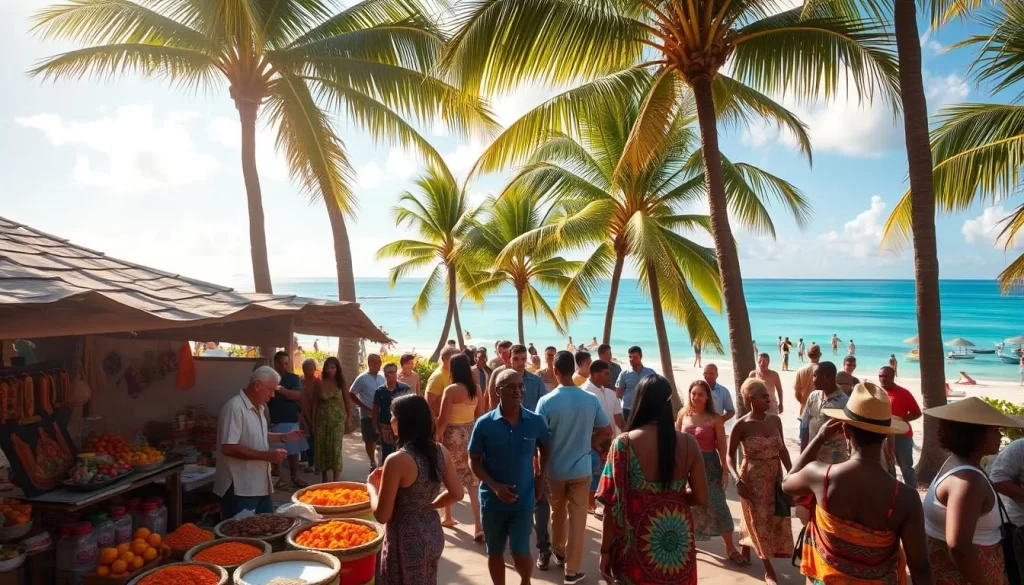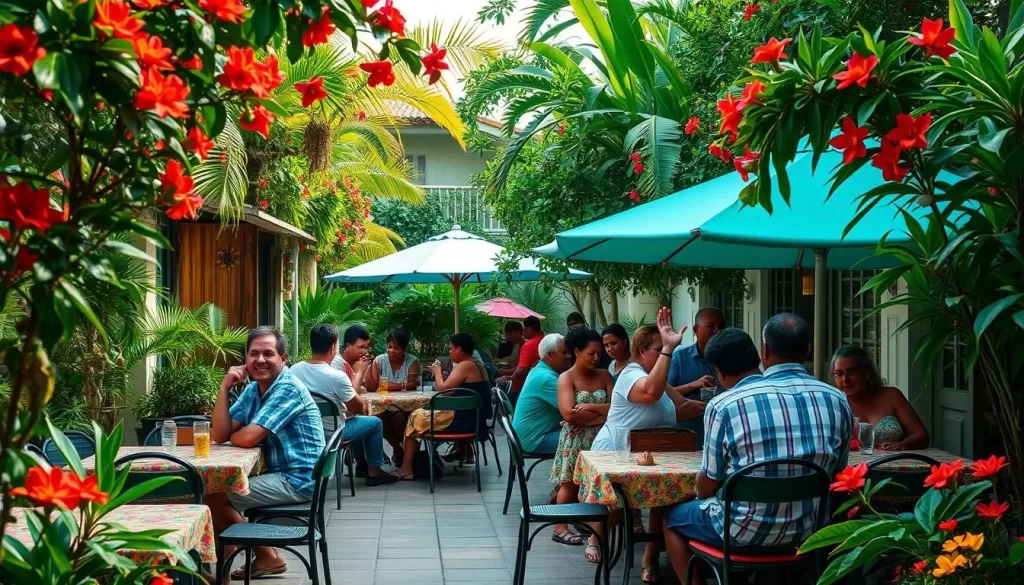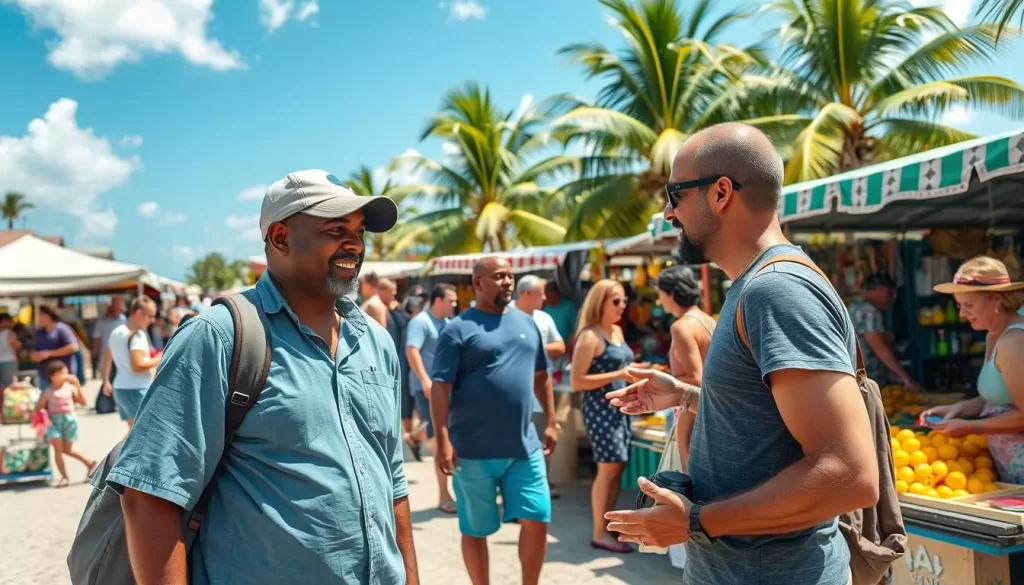When you visit the turks caicos islands, you’ll find a vibrant mix of cultures and traditions. As a British overseas territory, the islands’ official language is English. This makes it easy for travelers to communicate and explore the stunning landscapes.
The caicos islands are known for their cultural diversity. While English is dominant, you’ll also hear Creole variations and other languages spoken by immigrant communities. This blend adds a unique charm to your experience.
Whether you’re relaxing on the beach or exploring local markets, the islands’ linguistic heritage enriches every interaction. It’s one of the many reasons why the turks caicos is a top destination for travelers from the united kingdom and beyond.
Experience the Rich Linguistic Tapestry of Turks & Caicos
Exploring the islands reveals a fascinating blend of languages. This diversity reflects the population’s rich history and cultural influences. As a British overseas territory, English is the primary language, making it easy for visitors to navigate and connect with locals.
Official Language: English and Its Role
English dominates daily life, from business to tourism. Its widespread use ensures smooth communication for travelers. Historic ties with the united states and the country’s colonial past have reinforced its importance. Whether you’re dining at a restaurant or booking a tour, English is your go-to language.
Emergence of Creole Variations
Creole variations add a unique flavor to the linguistic landscape. These dialects blend English vocabulary with African grammar, creating a distinct local identity. Over the years, they’ve become a symbol of the island’s cultural heritage. Hearing these variations is like stepping into a living history book.
Embracing Multilingualism Among Locals
Immigration has introduced languages like Spanish and French into the mix. This multilingualism enriches the community and fosters inclusivity. Locals often switch between languages effortlessly, showcasing their adaptability. Engaging with this vibrant linguistic tapestry is a highlight of any visit.
Turks & Caicos: Official and widely spoken languages
Language in this region tells a story of colonization, migration, and cultural fusion. Over the centuries, European settlers, African heritage, and interactions with nearby nations like the Dominican Republic have shaped its linguistic identity. This blend is not just a part of history but a living, evolving part of daily life.
Historical Influences on Language Development
The islands’ linguistic roots trace back to European colonization. English became dominant due to British rule, but African influences introduced Creole variations. These dialects blend English vocabulary with African grammar, creating a unique local identity.
Regional interactions also played a role. Proximity to the Dominican Republic brought Spanish into the mix, enriching the linguistic tapestry. Over time, phrases and slang evolved, especially on Grand Turk, where cultural expressions thrive.

Modern Usage in Daily Life and Tourism
Today, English remains the primary language, making it easy for visitors to navigate. The tourism industry benefits from this linguistic heritage, offering seamless experiences for travelers. From booking tours to enjoying local music, communication is effortless.
Creole variations are still heard, adding authenticity to interactions. On Grand Turk, you’ll find locals proudly embracing their mixed heritage. This linguistic diversity enhances your vacation, offering a deeper connection to the islands’ culture.
Every day, the islands’ language reflects its vibrant history. Whether you’re exploring markets or relaxing on the beach, the words you hear tell a story of resilience and adaptation. It’s a part of what makes this destination so special.
Cultural Diversity: A Blend of Global Influences
The islands are a melting pot of cultures, shaped by centuries of migration and tradition. As a british overseas territory, they’ve welcomed people from around the world, creating a vibrant community. Over time, this mix has enriched the islands’ identity, making it a fascinating destination.

Immigration and International Communities
Immigration has brought together over 60 nationalities, each contributing to the islands’ unique character. From the Caribbean to Europe, these communities have added their traditions, languages, and cuisines. This diversity is evident in daily life, from local markets to social service interactions.
One of the most notable contributions is the islands’ historical salt industry. For centuries, salt production was a cornerstone of the economy, attracting workers from nearby regions. Today, this legacy is celebrated in cultural events and festivals.
Cultural Festivals and Celebratory Linguistic Practices
Festivals are a highlight of the islands’ cultural calendar. Events like the Conch Festival showcase local cuisine, music, and dance. These celebrations often feature a blend of languages, reflecting the islands’ multicultural roots.
On the beach, you’ll find lively gatherings where locals and visitors come together. These events are a perfect way to experience the islands’ friendly spirit and rich heritage. As one local puts it,
“Our festivals are a celebration of who we are and where we’ve come from.”
| Festival | Highlights |
|---|---|
| Conch Festival | Local cuisine, music, and dance |
| Salt Festival | Historical exhibits, traditional practices |
| Music Fest | Live performances, cultural showcases |
These festivals not only entertain but also educate, offering a deeper understanding of the islands’ history and traditions. Whether you’re enjoying a conch dish or learning about salt production, you’ll leave with a greater appreciation for this british overseas territory.
Mastering Local Creole and Useful Phrases
Learning a few local phrases can transform your travel experience. While English is widely spoken, using Creole expressions shows respect and helps you connect with the community. It’s a small effort that can make a big difference.

Common Greetings and Expressions
Start with simple greetings like “Bonjou” (Good morning) or “Bonswa” (Good evening). These phrases are easy to remember and instantly make you feel more at home. Saying “Mèsi” (Thank you) or “Tanpri” (Please) in everyday interactions shows politeness and appreciation.
Locals often respond warmly when they hear visitors using their language. It’s a great way to break the ice and start meaningful conversations. Whether you’re at a market or a restaurant, these phrases can enhance your experience.
Key Phrases to Enhance Your Visit
Here are some essential phrases to help you navigate the islands:
- “Ki jan ou rele?” (What is your name?) – Perfect for meeting new people.
- “Kote m ka jwenn yon bon manje?” (Where can I find good food?) – Ideal for discovering local cuisine.
- “Konbyen sa koute?” (How much does it cost?) – Useful for shopping or dining.
These phrases are especially helpful in the tourism industry. They allow you to communicate more effectively with service providers and enjoy a smoother experience.
| Phrase | Meaning |
|---|---|
| Bonjou | Good morning |
| Mèsi | Thank you |
| Tanpri | Please |
| Ki jan ou rele? | What is your name? |
Using these phrases not only helps you as a visitor but also fosters positive interactions with locals. It’s a way to bridge cultural gaps and show appreciation for their heritage. As one tourist shared,
“Speaking a few words in Creole made my trip unforgettable.”
Whether you’re exploring the conch markets or chatting with a group of locals, these phrases enrich your journey. A little effort goes a long way in making your stay memorable.
Interacting with Locals: Communication Tips
Connecting with locals can enrich your travel experience in meaningful ways. A warm greeting and a smile go a long way in building rapport. Whether you’re at a hotel or exploring a market, these simple gestures set the tone for positive interactions.

Etiquette and Friendly Engagement
Eye contact and a friendly “hello” are highly valued. Using basic phrases in english official language or Creole shows respect and effort. Most residents are bilingual, and they appreciate when visitors try to connect authentically.
In settings like hotel lobbies or local markets, politeness is key. A simple “thank you” or “please” can make a big difference. These small acts of courtesy help you blend into the community and create a welcoming atmosphere.
The majority of locals take pride in their cultural heritage. Asking questions about their traditions or history can lead to fascinating conversations. Respectful language use opens pathways to learn more about their world and way of life.
| Setting | Communication Tips |
|---|---|
| Hotels | Use polite greetings and ask for recommendations. |
| Markets | Engage with vendors using simple phrases. |
| Community Events | Show interest in local traditions and practices. |
By embracing these tips, you’ll feel more at home and connected to the community. As one traveler shared,
“Taking the time to engage respectfully made my trip unforgettable.”
Language Insights for a Memorable Vacation
Every word you learn reveals a piece of the islands’ vibrant history. Understanding local phrases isn’t just about communication—it’s about connecting with the culture on a deeper level. Whether you’re exploring South Caicos or enjoying a lively night event, language shapes your experience in meaningful ways.
For example, learning a term like “Bonjou” (Good morning) opens doors to warm interactions. These small efforts show respect and help you build rapport with locals. It’s a way to bridge cultural gaps and create lasting memories.
At night, language takes on a festive tone during local gatherings. Events like the Conch Festival or Music Fest are perfect opportunities to hear Creole variations and regional slang. These moments offer a glimpse into the islands’ rich heritage and vibrant community spirit.
In South Caicos, language tells stories of resilience and adaptation. Phrases used here often reflect the island’s unique history and traditions. By exploring these linguistic nuances, you gain a deeper appreciation for the culture and its evolution over time.
- “Ki jan ou rele?” (What is your name?) – A great way to start conversations.
- “Kote m ka jwenn yon bon manje?” (Where can I find good food?) – Perfect for discovering local cuisine.
- “Konbyen sa koute?” (How much does it cost?) – Useful for shopping or dining.
Exploring regional language variations is a fun and rewarding part of your trip. It’s not just about the words—it’s about the stories they carry. As one traveler shared,
“Learning a few phrases made me feel more connected to the islands and its people.”
Ready to dive deeper? Compare the linguistic charm of this destination with others like The Bahamas to see how each offers a unique experience. Every term you learn adds another layer to your adventure, making your vacation truly unforgettable.
How Language Shapes the Turks & Caicos Experience
Language is the heartbeat of every interaction in this tropical paradise. From the bustling streets of Providenciales to the serene shores of Salt Cay, communication connects people and cultures. Whether you’re exploring East Caicos or relaxing on West Caicos, understanding the local language enhances your journey.
The Role of Language in Tourism and Service
In the tourism industry, language is a key tool for creating memorable experiences. From check-ins at hotels to dining at local restaurants, clear communication ensures smooth interactions. On North Caicos, for example, staff often switch between English and Creole to cater to diverse visitors.
Effective communication also fosters trust and rapport. When service providers speak your language, it makes you feel welcome and valued. This is especially important in a territory known for its hospitality. A simple greeting or thank you in the local dialect can go a long way.
Bridging Cultural Gaps Through Communication
Language is more than just words—it’s a bridge between cultures. On Salt Cay, you’ll hear stories of resilience and tradition shared through Creole phrases. These conversations offer a glimpse into the island’s rich heritage.
In East Caicos, locals often use language to share their history and customs. By engaging with these narratives, you gain a deeper appreciation for the territory’s cultural tapestry. As one visitor noted,
“Learning a few phrases made me feel more connected to the community.”
Here are some ways language enhances your experience:
- Facilitates smoother travel: From booking tours to navigating markets.
- Builds cultural understanding: Through meaningful conversations with locals.
- Enriches dining experiences: By understanding menu items and local cuisine.
By embracing the local language, you not only navigate the islands with ease but also create lasting connections. It’s a small effort that makes a big difference in your territory adventure.
Conclusion
The islands’ linguistic diversity offers a unique window into their rich cultural heritage. From the bustling streets of Providenciales to the historic charm of Cockburn Town, language connects people and traditions. English dominates daily life, but Creole variations and other dialects add depth to every interaction.
Historical influences have shaped this vibrant linguistic tapestry. European colonization, African heritage, and regional interactions all play a role. Today, this blend enhances tourism, service quality, and cultural understanding. Whether you’re staying at a luxury resort or exploring local markets, language enriches your experience.
Visiting key locations like Providenciales Grand Turk allows you to immerse yourself in authentic local expressions. Learning a few phrases can deepen your connection to the community. Ready to explore? Discover more about the Turks and Caicos Islands and their vibrant culture.
The above is subject to change.
Check back often to TRAVEL.COM for the latest travel tips and deals.
Here are some Tours & Sightseeing suggestions that might pique your interests!




